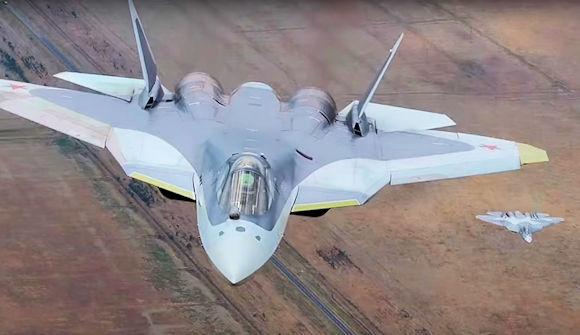The ninth T-50, equipped with the systems foreseen in the specifications of the Russian Ministry of Defense such as the AESA radar and the three-dimensional vector thrust control, started flight tests in final configuration a few hours ago. The tenth and eleventh prototype of the Sukhoi T-50 will fly by next January. The twelfth and final aircraft of the T-50 squadron will be delivered to the Ministry of Defense in eight months.
The twelve T-50 will continue to be subjected to various tests before committing the Kremlin with an order of several billion dollars. Started the Low Rate Initial Production, the cost of the PAK-FA should range from the 100 to the 120 million per sample.
The production plant of the Aircraft Association Komsomolsk-on-Amur, in the Russian Far East, will start mass production within the 2018, with deliveries of the first fighter stealth in the early months of 2019.
Meanwhile, Moscow is optimistic about second-generation engines. The T-50 is currently powered by a pair of AL-41F1, developed for the Su-35 Flanker-E. Although exceptional for pre-stealth, like the Su-35, the AL-41F1 engines were not designed for the particular profile of a fifth-generation fighter. The T-50 was designed for the innovative Izdeliye 30, but the development of the propulsion system will only be completed between the 2025 and the 2027 (although this estimate could be revised).
In 2018, the year in which the serial production of the T-50 should begin, the Russians are counting on having completed the development of second-generation engines. It should not be the Izdeliye 30, but a new version of the AL-41F1 capable of enhancing the features of the fifth generation platform. Second generation engines should allow certification of Initial Operational Capacity.
Propulsion is the most challenging and costly aspect of developing any aerial platform. From the reliable F119 turbofans of the F-22, for example, comes the Pratt & Whitney F135 of the F-35. The transition to what seemed like a simple evolution did not turn out to be so natural and free of technical difficulties, still partly unsolved today. The Russians confirm that the Pak-Fa will be built in a number between 800 and 1000 copies, including exports. For the T-50, an operational cycle of forty years is expected, with an estimated cost of $ 100 million per hunt. There is no data on the development costs incurred.
The T-50 represents the first experience for the Russians with absorbent radar materials, compared to the thirty-year experience gained by the Americans with the F-117.












